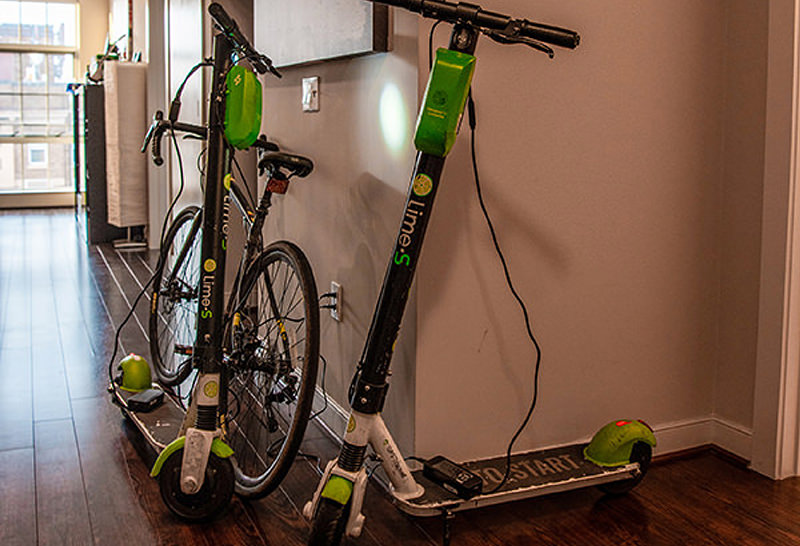Table of Contents
Integrated widely as a portable energy storage solution for modern technology and hardware, lithium-ion batteries are used almost exclusively in smartphones, laptops, and e-mobility devices like e-bikes and e-scooters. Acting as the key component in electric car batteries, lithium has come to be regarded as a key component of decarbonisation efforts.
Storing up to ten times more energy in the same space than a lead acid battery in a sensitive, high-density space, it’s arguably unsurprising that the rise in prominence of lithium-ion batteries in the developed world has, in recent years, been marked by an alarming rise in fire-related incidents, shedding light on some of the dangers involved with these devices.
With that in mind, it’s vital for landlords, housing associations, and local authorities to gain awareness of these now widespread devices, how they function as an energy storage solution, and the risks involved when poor storage and charging practices are involved.
How Do Lithium-Ion Batteries Function?
A lithium-ion battery is made up of 4 components: an anode, cathode, separator, electrolyte, as well as two current collectors for positive and negative. The anode and cathode store the lithium-ions, with the electrical current flowing from the current collector through the device currently receiving power to the negative current collector. The separator blocks the flow of electrons, and while the battery is providing an electric current, the anode releases lithium-ions to the cathode, generating a flow of electrons from one side of the battery to the other. The opposite occurs when charging a device.
Why Are Lithium-Ion Batteries Potentially Dangerous?
While lithium-ion batteries are generally safe to use when supplied by reputable manufacturers and operated in-line with their specifications, their high-density can be susceptible to overheating and pressure when damaged or poorly manufactured, causing the cells of the battery to disperse and potentially lead to a rapid, uncontrolled release of heat energy when the battery begins to enter failure conditions, a reaction known as ‘thermal runaway’. Fire temperatures can range from 1,000°C to 2,000°C, and they tend to escalate quickly, producing toxic gases that are hugely challenging to extinguish.
What Causes Failure Conditions?
Battery failure conditions can be brought on by several conditions related to storage, charging, and general handling of the device, including:
- When batteries are charged with incompatible equipment or overcharged following completion of this process
- If users neglect an appropriate cooling off time before charging, or charging multiple batteries at one time, overloading the circuit
- Batteries that are stored in improper conditions, such as in unventilated environments, close to heat sources, or when exposed to water directly
- Using cheap or unregulated batteries that haven’t passed specific safety tests
- External damage to the battery or manufacturing defects
Why Is This So Hazardous for Residential Settings?
Faulty or poor quality batteries present a significant fire hazard when charged internally in residential and commercial buildings; employees and tenants cannot solely assume that risk, as they potentially subject the whole building to the dangers. However, a lack of internal storage space in these buildings can encourage individuals to charge and store the battery overnight, or store an e-mobility device in communal areas, such as in narrow corridors and stairways that block fire escape routes.
In the event that a lithium-ion battery does enter failure conditions, oxygen released from the battery’s cathode can exacerbate the spread of any resulting fire and quickly eliminate opportunities for safe escape. In high-density settings, this can be particularly devastating and risks spreading to surrounding buildings.
What Has Been the Impact for Fire and Rescue Services?
The London Fire Brigade (LFB) considers lithium-ion battery fires to be the fastest developing fire-risk in the capital. From 2020-22, they were reportedly called to 246 battery-related fire incidents, while, in 2023, the LFB responded to an incident, on average, every 2 days, with 119 fires already reported by June. Across the UK, Fire and Rescue Services responded to 329 battery fires from 2022 to May 2023, contributing to a total 565 fires since the start of 2020. These figures demonstrate the potential severity of dangers associated with lithium-ion batteries.
What Steps Can Be Taken to Reduce These Risks?
- Always maintain fire escape routes that are free from any obstructions at all times
- Fit smoke and heat alarms in working condition, ensuring they are tested regularly
- Always avoid storing e-mobility devices in the home and away from any flammable materials to ensure optimal safety conditions
- Only buy batteries and chargers from a reputable seller that meet UK safety standards
- Only ever using the original charging equipment supplied with the device or an exact copy if a replacement is needed
- Avoid retrofitting regular push bikes or scooters using online-purchased DIY kits, this can be incredibly risky
- Check the condition of the battery intermittently for signs of improper function or damage, such as warped shaping
- Make sure batteries aren’t warm to the touch before charging and always unplug the charger to allow for an appropriate cool down period
- Always ensure the battery can be monitored at all times when charging
What Solutions Are Available for Safe and Secure Storage?
For e-mobility devices, secure external storage and charging facilities are the optimum solution for both short-term and long-term storage requirements. As a means of ensuring building safety and the security of the devices themselves, these are highly valuable solutions designed for external installation to ensure safe containment away from respective buildings, offering a fully enclosed unit to protect stored e-mobility devices and batteries from exposure to damage and inclement weather.
metroSTOR has developed a range of secure external storage and charging facilities from single locker format to communal hub buildings, with the metroSTOR modular system enabling additional capacity to be integrated in the event that further storage space is required. All units are configurable for fire-resistant enclosure specification to ensure effective, proven containment in the unfortunate event of a fire, as well as energy consumption metering, and access control.










